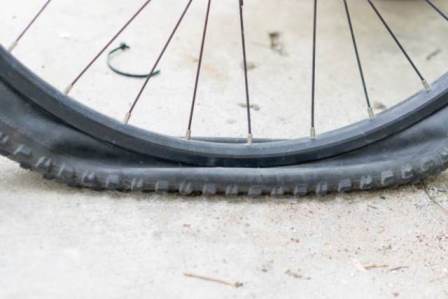Knowing how long a bike’s tires can last is not usually easy, and it can be challenging to figure out exactly when to replace them. Whether you commute to work daily or use your bike on weekends, the mileage you can get from your tires should be much more than just a matter of casual interest. You need to find tires that are engineered for your kind of riding.
The perfect time to replace your bike’s tire is when the knobs in its tread are more than halfway wholly worn down. When you can see the thread in the rubber and when the tire bulges in some spots, it means it is worn out. At this point, the tire cannot hold pressure. Another sign that it is completely worn out is when there is excessive cracking caused by dry rot.
When it comes to a tire's durability, many factors can affect it, making it difficult to predict. Such determinant factors may contribute to tire’s lifespan of within 3200 miles to 6000 miles, depending on which factors are in play and how much each plays. The above lifespan range is mainly common in high-end tires. That is not to say your tires cannot last less or longer than that.

Factors Affecting Tire Durability
Things like brand, thickness, and the material combination can affect the tire’s durability. Tires of bikes used almost daily to commute or for other high-activity purposes such as racing can last between 1000 to 3000 miles; before it is completely worn out. Simple road or hybrid tires may also last between 1000 to 3000 miles even without being used in high-activity riding.
A tire’s construction also affects how long it will last before you should replace it. They are either made of soft rubber or hard rubber. Tires made of soft rubber offer more traction and grip but wears off easily. On the other hand, hard rubber is more durable but gives less control.
Hybrid tires combine both rubber types in their construction, with soft rubber placed on the outside for improved grip, while hard rubber is retained between the casing and tread for improved cornering and grip.
How To Make Your Bike’s Tires Last Longer
There are measures you can take to make your bike’s tires last longer. For instance, you can clean them after every ride to remove the micro road grits that may be adhering to your tires.
You can also use puncture-resistant tires instead of normal tires and add a tire liner between each tire and tube. Every time you fix a flat, do not just fix it on the tube. You should also seal the slit or puncture in the tire with epoxy or super glue, squeezing the substance into the wound.
You can also rub a flat sealant inside the surface of a wounded tire to extend the tire’s life and reduce flats. If you normally ride in thorny places, you should install thorn resistant tires, which are usually thicker and heavier.
Make it a routine to closely inspect your bike tires for any embedded wires or serious cuts after every ride. Whenever you find any, use a kit to remove any wires that pose a danger to the tube and fix any cuts.
When To Replace Your Bike’s Tires
There are several signs that your tires are completely worn out and need replacement. You need to check the five essential parts of the tire whenever you examine them to see if they need replacement. The five crucial parts of a tire include the casing, a protection layer, bead, tread, and anti-chafing strip. However, there are other factors you need to check, not just those parts.
Tread Erosion:
The reads on your bike’s tires are where form meets function. There are various tread patterns, with each pattern offering a unique aesthetic and performance in gripping the surfaces and increasing friction.
The pattern of knobs and grooves has a significant influence on the tire’s overall performance.
Their knobby protrusions provide the traction needed to maneuver and accelerate in loose dirt and sand. The shallow grooves on the tires help channel water out of your path, making it safer to ride your bike in wet conditions.
When the treads are worn out enough to hinder their performance, you should know better to replace the tires immediately. Tires can only last as long as the treads.
Repeated Flats:
You know your bike’s tires have reached the end of the road when it experiences repeated flats. It may lack tread wear indicators but repeatedly gets flats from pieces of glass and small stones.
This indicates that the tire has gotten very thin from the effect of wear. When the rubber reaches this stage, you may notice it when the casing or protection layer is showing through. That would be the perfect time to replace it with a new one.
Worn Sidewalls:
The tire’s sidewall can wear out before the treads. In that case, the situation is considered a premature failure and is caused by prolonged rubber use with insufficient inflation pressure.
You can avoid that by checking and adjusting inflation pressure in your tires regularly with a pressure gauge. Likewise, when you leave your bike on flat tires for a long time, it will damage the side walls.
Final Verdict
Bike tires are often known to last anywhere from 1000 miles to 3000 miles. However, high-end models should give you at least 2500 miles before replacement becomes necessary. Racing tires are designed for high performance and speed, making them short-lasting and may have to be replaced after just 1000 miles of use.
It is the tough touring models that can last as long as 6000 miles. Therefore, as you can see, a lot of things influence how long bike tires last. Before selecting your next tires, consider all the above factors, and use the tips provided here to choose accuracy.

Hello Guys! I am John Reese, a professional biker and my hobby is biking! I have been biking for last 10 years and I love using bikes while outing as well. Based on my experiences with the different type of bikes (mountain bikes, road bikes and hybrid bikes); I am sharing my opinion about various bikes so that a beginner can get started right away. Happy reading!

